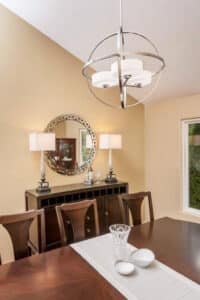You undoubtedly have heard of rhythm as it relates to music. But did you know that rhythm is also an important concept in interior design? Rhythm in interior design refers to the illusion of movement through a space. Rhythm keeps the eyes traveling around the room and makes a room look lively and interesting. Rhythm in a room can be created in a number of ways:
 Repetition of a design element such as shape, color, texture, line or pattern. For example, think of a striped fabric pattern in which the colors yellow, red and brown repeat. The repetition of colors and lines implies a sense of movement and rhythm. As another example, a trio of woven baskets on a shelf shows repetition of texture. As I look in my own living and dining rooms, I see my accent color, blue, repeated around the room: a cobalt blue glass floor vase, navy and cream pillows on the sofa, a blue platter on the coffee table, and navy fabric on the dining chair seats. This repetition of color leads the eye to all of the different elements in the room, tying them all together.
Repetition of a design element such as shape, color, texture, line or pattern. For example, think of a striped fabric pattern in which the colors yellow, red and brown repeat. The repetition of colors and lines implies a sense of movement and rhythm. As another example, a trio of woven baskets on a shelf shows repetition of texture. As I look in my own living and dining rooms, I see my accent color, blue, repeated around the room: a cobalt blue glass floor vase, navy and cream pillows on the sofa, a blue platter on the coffee table, and navy fabric on the dining chair seats. This repetition of color leads the eye to all of the different elements in the room, tying them all together. Gradation refers to the gradual movement from a low point to a high point or from high to low. In interior redesign we often refer to the concept of “peaks and valleys,” which means that the furniture and accessories are arranged to create highs and lows. Think of three candles on the dining table ranging in size from short to tall. Or think of a tabletop arrangement in which the eye travels from the top of a tall lampshade down to a shorter framed photo, down to a velvet-covered box.
Gradation refers to the gradual movement from a low point to a high point or from high to low. In interior redesign we often refer to the concept of “peaks and valleys,” which means that the furniture and accessories are arranged to create highs and lows. Think of three candles on the dining table ranging in size from short to tall. Or think of a tabletop arrangement in which the eye travels from the top of a tall lampshade down to a shorter framed photo, down to a velvet-covered box.- Transition— Curved lines are a good example of this type of rhythm. With a curved line, your eye gently transitions, or travels, from one object to another. Think of a camelback sofa, for example, a curved headboard, or an archway.
 Opposition— Using opposites can create an interesting and pleasing effect in your decor. Using colors opposite each other on the color wheel is one example of oppositional rhythm. Complementary colors such as purple and yellow, for example can create a jarring, yet desirable effect. Pairing black and white, always a classic combination in home decor, is another great look in a room. Mixing textures, such as pairing a smooth leather sofa with a rough slate-topped coffee table, is another example of oppositional rhythm.
Opposition— Using opposites can create an interesting and pleasing effect in your decor. Using colors opposite each other on the color wheel is one example of oppositional rhythm. Complementary colors such as purple and yellow, for example can create a jarring, yet desirable effect. Pairing black and white, always a classic combination in home decor, is another great look in a room. Mixing textures, such as pairing a smooth leather sofa with a rough slate-topped coffee table, is another example of oppositional rhythm. Radiation— This type of rhythm refers to several objects repeated around a center object creating a circular pattern. For example, think of a chandelier in which crystals surround the centerpiece of the light fixture. Dining chairs around a dining table is another simple example.
Radiation— This type of rhythm refers to several objects repeated around a center object creating a circular pattern. For example, think of a chandelier in which crystals surround the centerpiece of the light fixture. Dining chairs around a dining table is another simple example.
Take a look around your home for evidence of rhythm. Could you rearrange a few pieces to create highs and lows? Could you find ways to repeat your accent color in different areas in the room? With a few changes, your room could be a symphony of beautiful music.

